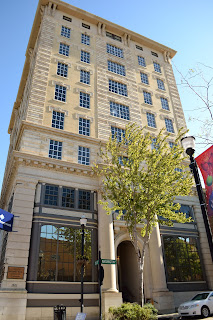Years ago floods and battles had a devastating effect on the city of Vicksburg. Most recently the flood of 2011 the Mississippi River spilled over her banks causing massive destruction and loss of lives. The picture below shows the flood marks that have occurred in Vicksburg. Above Susan's head is the 2011 gage mark of 57.1 feet.
The Mississippi River drains 41% of the continental US. The basin covers more than 1,250,000 square miles including 2 Canadian Provinces. So, the moral of the story is when there are heavy rains in the spring and winter ice and snow melt there will be flooding. Levee walls are built to help contain the flooding. To beautify the city, artists were commissioned to paint murals on the wall depicting the history of Vicksburg. Below shows Washington St in 1839 becoming the commercial center for Vicksburg.
In 1894 Joseph Biedenham took the popular soda fountain drink Coca Cola bottled it and went door to door in rural areas selling it. It was the first time Coca Cola had been bottled.
President Theodore Roosevelt was hunting bear in the woods. His scout had cornered a young cub. Not wanting to shoot it, the term Teddy's Bear was coined by toy manufacturers, later it was changed to Teddy Bear.
After touring the downtown area I sure needed some lunch. So who better than to ask but the locals in the area. They all suggested a place called 10 South Rooftop Bar & Grill which is on the corner of Washington and Clay Street. Amazing views of the Mississippi and Yazoo Rivers.

 |
| View of The Old Courthouse & Downtown Vicksburg |


 Oh yes, we can't forget the warm spiced pretzels with a sweet cajun mustard.
Oh yes, we can't forget the warm spiced pretzels with a sweet cajun mustard.Before leaving Vicksburg one of the must things to see and do is spend time at the Vicksburg National Military Park. We started our tour at the visitors center watching a 20 minute film which recounts the campaign of Vicksburg and surrounding area. After the film our 16 mile driving tour took us past monuments, markers, plaques, a restored Union gunboat, and a national cemetery.
The Vicksburg National Military Park was established in 1899 to honour the soldiers and sailors that fought in the campaign.
The Massachusetts Memorial was the first state memorial erected at the park. It was dedicated in November 1903.

In 1862 congress sanctioned black enlistment but it was the Emancipation Proclamation that opened the door for runaway slaves and free men of colour. Nearly 175 regiments of over 178,000 free men and former slaves served during the campaign.
The Battle of Vicksburg began May 19, 1863 and ended July 4, 1863 calling it the 43 day war. Located on a strategic bend of the mighty Mississippi River, Confederate troops fortified the bluffs with an array of artillery. General Ulysses S Grant had the task of conquering the "Gibraltar of the Mississippi". It was not the Union attacks but starvation that caused the Confederate army to surrender.
 |
| Ulysses S. Grant statue |
A tunnel was built by Union troops to provide safe passage under the exposed ridge from Confederate sharpshooters high up on the hill. Union soldiers were able to inch closer to Confederate troops by digging zigzag trenches. This helped to nullify the effects of Confederate gunfire.

Unlike wooden sailing vessels used at the start of the civil war, the new ironclads had steam driven engines, armour plating, 13 cannons, and a top speed of 9 mph. The Cairo (pronounced Care-o) steamed up the Yazoo River. On December 12, 1862 two quick explosions tore holes in the bottom of ironclad causing it to sink in minutes. Preserved by mud and silt the Cairo sat on the bottom of the river for 102 years before it was raised in 1964.










No comments:
Post a Comment